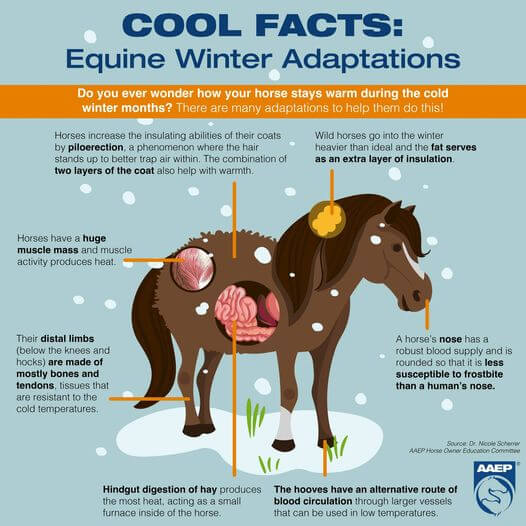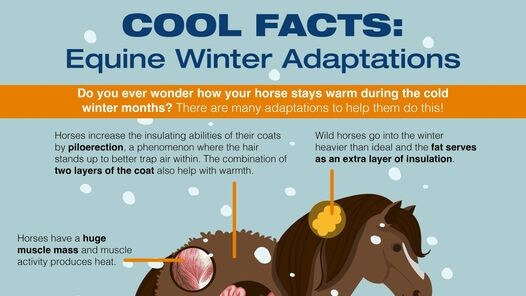Are you familiar with the many adaptations that help your horse stay warm during the cold winter months?
![]() Hindgut digestion of hay produces the most heat, acting as a small furnace inside of the horse. This is why free choice, good quality hay is so important in the winter.
Hindgut digestion of hay produces the most heat, acting as a small furnace inside of the horse. This is why free choice, good quality hay is so important in the winter.
![]() Horses have a huge muscle mass and muscle activity produces heat. This includes running and playing and even shivering if their body temperature starts to drop. It is important to remember that these activities also will result in a bigger caloric demand so free choice hay and in some cases, grain, is often needed.
Horses have a huge muscle mass and muscle activity produces heat. This includes running and playing and even shivering if their body temperature starts to drop. It is important to remember that these activities also will result in a bigger caloric demand so free choice hay and in some cases, grain, is often needed.
![]() To blanket or not to blanket is a constant debate but either way, as it starts to get cold your horse will grow a thicker coat. If you decide to leave your horse unblanketed you may notice that they look “fluffy”. This is due to a phenomenon called piloerection where the hair stands up to better trap air within. Two layers of the coat also help with warmth. The inner layer is softer and has air pockets to create an insulating layer. The outer layer is coarse and has oils that keep moisture from penetrating the insulating layer and keep the horse warm.
To blanket or not to blanket is a constant debate but either way, as it starts to get cold your horse will grow a thicker coat. If you decide to leave your horse unblanketed you may notice that they look “fluffy”. This is due to a phenomenon called piloerection where the hair stands up to better trap air within. Two layers of the coat also help with warmth. The inner layer is softer and has air pockets to create an insulating layer. The outer layer is coarse and has oils that keep moisture from penetrating the insulating layer and keep the horse warm.
![]() Wild horses go into the winter heavier than ideal and the fat serves as an extra layer of insulation. However, if a horse is going to be kept heavily blanketed and in a barn during the cold weather months this is unnecessary and can lead to obesity related issues.
Wild horses go into the winter heavier than ideal and the fat serves as an extra layer of insulation. However, if a horse is going to be kept heavily blanketed and in a barn during the cold weather months this is unnecessary and can lead to obesity related issues.
![]() Their distal limbs (below the knees and hocks) are made of mostly bones and tendons, tissues that are resistant to the cold temperatures.
Their distal limbs (below the knees and hocks) are made of mostly bones and tendons, tissues that are resistant to the cold temperatures.
![]() The hooves have an alternative route of blood circulation through larger vessels that can be used in low temperatures. This is why horses can stand in snow without detrimental effects.
The hooves have an alternative route of blood circulation through larger vessels that can be used in low temperatures. This is why horses can stand in snow without detrimental effects.
![]() A horse’s nose has a robust blood supply and is rounded so that it is less susceptible to frostbite than a human’s nose.
A horse’s nose has a robust blood supply and is rounded so that it is less susceptible to frostbite than a human’s nose.

Courtesy of the AAEP Horse Owner Education Committee


